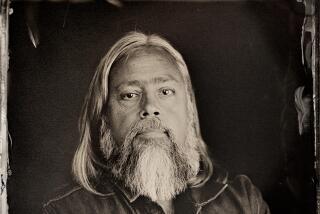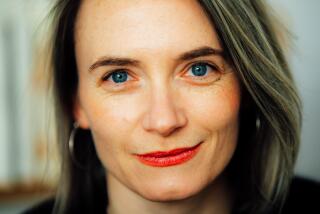It’s solitude, but it’s not loneliness
WESTPORT, N.Y. — The petite woman in the lumberjack shirt leads her German shepherd past the “No Pets” sign and straight into the cafe -- saying it’s cold out and they should let the dog stay.
“I’m always for trying stuff,” Anne LaBastille says as she opens the door. She’s tried plenty during decades living in the wilderness cabin she built, conducting field research in Central American jungles, surviving a divorce, earning a science Ph.D. from Cornell, enduring turbulent years on the Adirondack Park Agency board, guiding in the outdoors, and writing about much of this experience in books and articles.
In 1997’s “Woodswoman III,” the autobiography covering her third decade living in a cabin in the woods, she urged older women, those of her generation, to follow: “Become a fierce eco-feminist and care for Planet Earth.”
That was her response to the arsonist, never caught, who torched her barns five years earlier, presumably because of her environmentalist positions on the Adirondack Park Agency.
“She was a very reliable green vote,” recalls Robert C. Glennon, former park agency counsel and executive director. “She was a valiant lady.”
The board regulates development in the 6-million-acre Adirondack Park. Its restrictions and other decisions have sometimes angered locals, prompting loud protests and worse.
“It was very hurtful,” LaBastille says of the barn fire. And the hard experience has made her cautious still, 15 years later. She won’t readily give out her phone number or directions to her house.
She won’t divulge the real names of the homesteads that in her writing she euphemistically called Black Bear Lake, where she built her first cabin, or Lily Pad Lake, where she described building the second to get farther from intrusions.
She wrote once about the kayaker who, years ago, tracked down the photogenic blond from clues in her first “Woodswoman” book and startled her as she was working at a typewriter on her sun deck in a bikini. She was not amused, and would not let him step onto her property.
“You never know who the fruitcakes are and who the real people are,” she says. Her hair is white now, held back by a pair of hair clips, her face lined. She won’t tell her age.
In jeans, sneakers and red-and-black checked shirt, LaBastille looks smaller than Krispy Kreme, her big dog, one in a long line of German shepherds that have been her steady companions. “They’re so loyal and so affectionate,” she says, though they make some people nervous.
When she and the dog enter the restaurant, the manager backs up a step, then insists that the animal can’t stay.
LaBastille reluctantly leads the dog out to her pickup truck, runs the engine for a while to warm it up, then returns inside for lunch at a table overlooking the truck, the Westport street and the broad green park rolling down to vast blue Lake Champlain.
“Nobody’ll steal her around here,” she says. “If they do, I’ll chop their heads off.”
In addition to her cabin, LaBastille has a house in Westport, with a pond and 42 acres of farmland. It’s “a lot to take care of,” she says, adding that she aims to sell it. She wants to get back to the cabin, though not in winter anymore.
She grew up in Montclair, N.J., the only child of a languages professor and a concert pianist who emphasized manners and dancing classes. “What I wanted to be, I wanted to live outdoors and be an Indian and everything you read about when you’re little,” LaBastille recalls.
The environmental and feminist movements began around 1970, LaBastille notes, but she headed years earlier for the outdoors and a career in sciences dominated by men. Cornell set her directly on the path.
“That was the best thing in my life. I was studying biology and ornithology and all of the things that could be taken in with nature,” she says. “On the back of that . . . I was going to be some kind of explorer, and it came true, more or less.”
Summer work in the Adirondacks led to marriage to an innkeeper, several years helping run the inn, divorce, then the cabin deeper in the forest. Over a decade, she completed a Ph.D. in wildlife ecology and taught at Cornell to help pay the bills.
“Moving into my little hand-built cabin on 22 acres of old-growth forest in 1965 gave me time to build up a reputation as a reliable freelance writer and ecological consultant,” she would write.
Along the way she had also learned to shoot, use a chain saw, study the way humans can obliterate other species. Her thesis research was the ecology of the giant pied-billed grebe, a flightless bird found then only at Lake Atitlan in the Guatemalan highlands, now extinct.
“Why did this bird suddenly disappear and it would not be back again?” LaBastille asks. “It was a very tragic thing.”
In “Woodswoman,” the 1976 autobiography that has sold more than 100,000 copies, she recounted an overloaded boat of hunters lost in a November snowstorm who arrived at her end of the Adirondack lake at dusk.
She moved two of the five into her own small boat and led the others 1.5 miles to the launch and parking area, then motored home alone, with little visibility despite a flashlight. “Frigid waves lashed the side of the boat, drenching me with spray which quickly turned to ice. Inching toward shore by dead reckoning, I just missed smacking into the granite rocks off my point.”
In these North Woods, she wrote, decisions are always made in favor of helping others.
But 1992, the second-to-last of her 17 years on the park agency board, would test that notion and show another side of the Adirondacks.
“We had guys hanged in effigy. We had all kinds of manure on the front porch,” Glennon recalls of those park agency days. “We had angry mobs, substances in the mail. Three guys in a car were shot at. A bullet hit the car.”
“What made me very sorry was when her barns were burned,” he says. “It just terrified her. Somebody set it. It was a way of trying to scare her. There was eco-violence then.”
LaBastille herself sums up her time on the board: “There was so much to learn. It was my second Ph.D.”
Soon after the fire, she left the park agency, slept with a gun for several years. She wrote that the experience hardened her heart to the Westport farm that she says became little more than a summer food supply and winter way station from the cabin, which became more refuge than ever.
Walking in Westport on a recent damp morning with winter approaching, LaBastille keeps noticing things -- like the flock of ducks flying in, the beauty of the water.
But something else infused life at the cabin: “A lot of solitude,” she says.
“We all need more of that.”
More to Read
Sign up for The Wild
We’ll help you find the best places to hike, bike and run, as well as the perfect silent spots for meditation and yoga.
You may occasionally receive promotional content from the Los Angeles Times.






